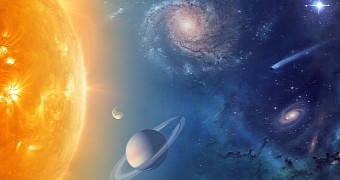This past Tuesday, science and engineering experts gathered at NASA's headquarters in Washington, DC, to discuss recent studies concerning the distribution of water and organics across our Solar System.
Talks about how the Sun influences the habitability of the celestial bodies orbiting it were also on the agenda, as was our quest for alien life either on neighboring planets in the Solar System or on orbs circling distant stars.
The panel discussion, held in the Webb Auditorium, aired on NASA Television between 1 and 2 p.m. EDT (10 and 11 a.m. PDT). In case you missed it, you can watch it in full in the video below.
We won't be alone for much longer
During yesterday's panel discussion in Washington, DC, NASA chief scientist Ellen Stofan said that, what with the scientific and technological advances made in recent years, we could find definite proof of alien life within 10 years, 20 tops.
“I think we're going to have strong indications of life beyond Earth within a decade, and I think we're going to have definitive evidence within 20 to 30 years,” Ellen Stofan argued.
“We know where to look. We know how to look. In most cases we have the technology, and we're on a path to implementing it. And so I think we're definitely on the road,” the scientist went on to explain.
Mind you, Ellen Stofan doesn't mean we'll be sipping tea and eating biscuits with teeny tiny green creatures with an extra pair of eyes anytime soon. This is not the kind of alien life NASA and other space agencies hope to find.
What the NASA chief scientist expects will be discovered on alien planets or moons in or outside our Solar System in the years to come is extraterrestrial microorganisms such as microbes.
The best candidates in the Solar System
Earth, the only celestial body that we know for a fact can sustain life, has a surface-land-to-water ratio of 29% to 71%. Still, it's not the only watery world in the Solar System.
The dwarf planet Ceres, orbiting the Sun between Mars and Jupiter, is believed to comprise about 25% water ice, maybe even hide an ocean under its surface. Europa and Ganymede, both moons of Jupiter, are also suspected of hiding underground oceans.
Calisto, also a moon of Jupiter, is known to pack a layer of ice measuring 124 miles (200 kilometers) in thickness. Some say an ocean could be hiding under all this ice.
Subsurface oceans appear to also be present on Mimas, Titan and Enceladus, all moons of Saturn, as well as on Neptune's moon Triton and on the dwarf planet Pluto. Otherwise put, there are plenty of places where life forms could have emerged over the millennia.
What about life outside the Solar System?
Come 2017, NASA will launch its TESS (Transiting Exoplanet Survey Satellite) mission, whose goal will be to identify Earth-like planets around stars in our solar neighborhood.
Of these planets, those that look like they might hold water will be studied in detail with the help of the James Webb Space Telescope, currently under construction and scheduled to launch in October 2018.
“The night sky may be full of exoplanets formed by similar processes to our home world, where gentle waves wash against the shores of alien seas,” NASA scientists say.

 14 DAY TRIAL //
14 DAY TRIAL // 